Compression Basics
Last updated on 3/31/2016By Scott Stepenuck
If you have ever recorded a guitar solo that you wish had more sustain, or a vocalist that is too soft at some points and too loud in others, or perhaps a bass or percussion track is lost in the background and just not punchy enough, this article is for you.
The concept:
A compressor is like having your own private recording specialist that listens to your track and continually adjusts the volume to reduce it at the highest points to make the overall average sound appear louder and or more balanced.
The parameters:
Compressors have five basic controls -
1) Attack – represents how long it takes for the effect to reach its maximum level.
This control is measured in milliseconds (ms). A fast attack is useful for catching percussive peaks, to tame them so the overall track level can be increased, useful for adding punch to a track.
2) Release – represents after the effect is activated, how long it takes to let go of a signal after it has gone below the specified threshold. This control is measured in milliseconds (ms). A long release is useful for adding sustain to a signal, good for guitar solos.
3) Threshold – this is the point at which the level is set for the compressor to begin working. This control is measured in decibels (db).
4) Ratio – this control governs the amount of compression applied to a signal once the threshold has been exceeded. This control is measured in decibels (db). In simple terms, for example a 4:1 ratio means for every 4 decibel of input that exceed the threshold, 1 decibel of output will be passed. If we set a 10:1 ratio, 10 decibels above out threshold would only out put 1 decibel in level.
5) Output – This governs the overall output level of the effect. This can be useful to ‘make-up’ the output level that will be reduced from applying compression to a signal. This control is measured in decibels (db).

Usage:
The above waveform depicts a typical waveform 1 and ½ measures long, or six beats. If we normalized the above item, only the 2, 4, and 6th beat would be maximized, but the overall level would not change much. But if we applied compression, assuming the peaks were at zero db (maximum volume), and we were to set a threshold of –10 db, with say a ratio of 10:1 and increase the output level to +5 - 10 db, we would reduce the peaks and bring the overall average volume level up to make that track more present or louder in the mix.
Let's use some real examples.
Ex.1
In Sonar, bring up a track with a drum loop or beat. Insert the Cakewalk FX Compressor plug in into that track. Select preset “Radio Compression”, set the attack time to 0.1 and the output to 3.4. This will increase the punchyness and overall level or your track. This preset works well for bass as well.
Ex.2
Let's bring up a track with a guitar solo on it and insert the Cakewalk FX Compressor plug in into that track. If you have a clean guitar track (without distortion on it), you may insert the “Cakewalk Amp Sim” plug in after the compressor to add distortion to your signal. Select compressor preset “Guitar Sustain”, set the release parameter to 3000.0, adjust the Compressor threshold and out level to taste, and you should find a substantial increase in sustain to your signal.
Ex.3
For the final example, bring up a vocal track, insert the Cakewalk FX Compressor plug in, and select the “Light Vocal Compression” preset. Start by using a fast attack time, adjust the threshold and ratio as the track plays back to affect more or less of the track as desired. You can finally adjust the output level to get an acceptable volume level. You should find that this will help balance the difference between loud and soft passages within a track and give a ‘balanced’ sound to the track.
Compressors are important not only on individual tracks, but also in sub-mixes and final mixes, try inserting a compressor in a main output and compressing an entire mix to give it a more polished sound, before burning it onto a CD.